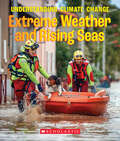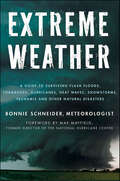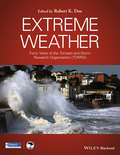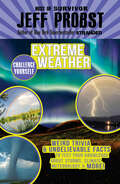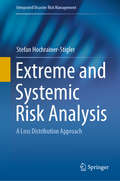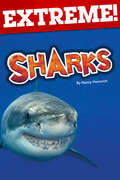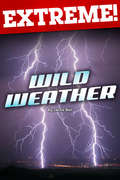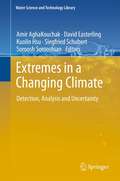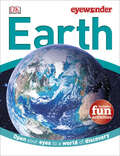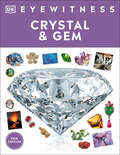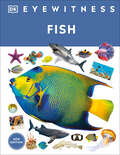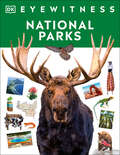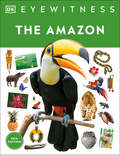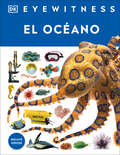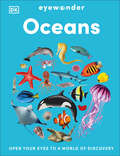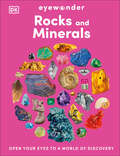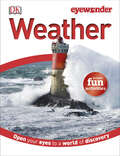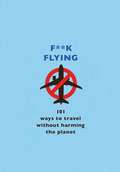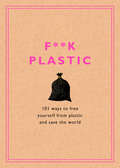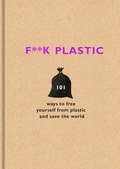- Table View
- List View
Extreme Weather and Rising Seas (A True Book (Relaunch))
by Karina HamalainenWhat is the difference between climate and weather? How does ice melting at the South Pole affect sea levels thousands of miles away?This book explains how climate change contributes to rising sea levels and hazards such as heat waves, droughts, and extra-powerful storms. Learn how scientists analyze these extreme events and predict how they might change in the future.Glaciers are melting. Summers are heating up. Sea levels are on the rise. Climate change is affecting every corner of our planet - and it's the subject of a lot of concern, activism, and debate. STEM meets current events in this new A True Book set that offers readers the chance to learn about the causes and effects of climate change, as well as how people around the world are reacting to it. Students will read about the history and scope of the problem, analyze the same kinds of evidence that scientists do, and come away with tools that will help them respond to this pressing global issue.This series covers Next Generation Science Standards core ideas including Weather and Climate, Human Impacts on Earth Systems, Conservation of Energy and Energy Transfer, and Biodiversity and Humans.
Extreme Weather: A Guide To Surviving Flash Floods, Tornadoes, Hurricanes, Heat Waves, Snowstorms, Tsunamis and Other Natural Disasters (MacSci)
by Bonnie SchneiderFlash floods, tsunamis, earthquakes, hurricanes, mudslides, thunderstorms, and wildfires - these devastating events are happening around the world at an alarming rate. As a Meteorologist on CNN and HLN, Bonnie Schneider reports on these natural disasters, explaining when they're likely to strike, and telling viewers how to respond when they do. In Extreme Weather, Schneider distills that information into a guide for readers. She interviews experts from a wide variety of agencies - including FEMA and NOAA - to provide a comprehensive understanding of the science behind weather patterns and the latest thinking on how to act in dangerous conditions. Ranging from topics that cover every season and every climate, Schneider introduces the reader to the best course of action during weather emergencies, including:*how to handle extreme weather scenarios in your car, outside, on a boat or at home*how to prepare for potential dangers, such as deadly lightning, when planning a camping trip, vacation or sports outing*what you need to have at home to protect against floods, earthquakes, or severe storms*how to protect your home from rapidly spreading wildfire*how to create a family evacuation plan for different emergencies*making sure your beloved pet is taken care of in time of disasterDrawing on actual survivor stories, Extreme Weather reminds readers that disaster can strike at any time, changing your life forever.*making sure your beloved pet is taken care of in time of disasterDrawing on actual survivor stories, Extreme Weather reminds readers that disaster can strike at any time, changing your life forever.
Extreme Weather: Forty Years of the Tornado and Storm Research Organisation (TORRO)
by Robert K. DoeThis book is about weather extremes in the United Kingdom. It presents fascinating and detailed insights into tornadoes (supercell and non-supercell tornadoes, historical and contemporary case studies, frequency and spatial distributions, and unique data on extreme events); thunderstorms (epic event analysis and observing); hailstorms (intensity, distributions and frequency of high magnitude events); lightning (lightning as a hazard, impacts and injuries); ball lightning (definitions, impacts and case studies); flooding (historical and contemporary analysis, extreme rainfall and flash flooding); snowfalls (heavy snowfall days and events). It also looks at researching weather extremes, provides guidance on performing post-storm site investigations and details what is involved in severe weather forecasting. It is written by members, directors and past and present Heads of the research group the Tornado and Storm Research Organisation (TORRO). With fifteen chapters thematically arranged, and data appendix including a new tornado map of the U.K., this book presents a wealth of information on meteorological extremes. This volume is aimed primarily at researchers in the field of meteorology and climatology, but will also be of interest to advanced undergraduate students taking relevant courses in this area.
Extreme Weather: Weird Trivia & Unbelievable Facts to Test Your Knowledge About Storms, Climate, (Challenge Yourself #4)
by Jeff ProbstCHALLENGE YOURSELF! A nature-based trivia series with vibrant visuals and fascinating facts. Discover the most extreme weather on earth!From Emmy-Award winning host of Survivor and New York Times bestselling author of Stranded, Jeff Probst comes a dynamic and graphic line of trivia books! Packed with full-color photos, fascinating facts and trivia, and great callouts from Jeff, this series is perfect for every kid looking to know the coolest, weirdest facts and trivia around! Challenge yourself to discover the world&’s most extreme weather--from hurricanes and tornadoes to blizzards, avalanches, and snow storms and much, much more!
Extreme and Systemic Risk Analysis: A Loss Distribution Approach (Integrated Disaster Risk Management)
by Stefan Hochrainer-StiglerThis book is about how extreme and systemic risk can be analyzed in an integrated way. Risk analysis is understood to include measurement, assessment as well as management aspects. Integration is understood as being able to perform risk analysis for extreme and systemic events simultaneously. The presented approach is based on Sklar's theorem, which states that a multivariate distribution can be separated into two parts – one describing the marginal distributions and the other describing the dependency between the distributions using a so-called copula. It is suggested to reinterpret Sklar's theorem from a system or network perspective, treating copulas as a network property and individual, including extreme, risk as elements within the network. In that way, extreme and systemic risk can be analyzed independently as well as jointly across several scales. The book is intended for a large audience, and all techniques presented are guided with examples and applications with a special focus on natural disaster events. Furthermore, an extensive literature and discussion of it are given in each chapter for the interested reader.
Extreme physics
by Jeff Colvin Jon LarsenMost matter in the Universe, from the deep interior of planets to the core of stars, is at high temperature or high pressure compared to the matter of our ordinary experience. This book offers a comprehensive introduction to the basic physical theory on matter at such extreme conditions and the mathematical modeling techniques involved in numerical simulations of its properties and behavior. Focusing on computational modeling, the book discusses topics such as the basic properties of dense plasmas; ionization physics; the physical mechanisms by which laser light is absorbed in matter; radiation transport in matter; the basics of hydrodynamics and shock-wave formation and propagation; and numerical simulation of radiation-hydrodynamics phenomenology. End-of-chapter exercises allow the reader to test their understanding of the material and introduce additional physics, making this an invaluable resource for researchers and graduate students in this broad and interdisciplinary area of physics.
Extreme: Sharks
by Nancy HonovichGo face-to-face with the world's most awesome predators! Extreme: Sharks is packed with incredible photos of the most fascinating creatures in the sea!
Extreme: Wild Weather
by Jackie BallExperience the most awesome power on Earth: wild weather! From destructive thunderstorms to devistating tornados, wild weather can appear out of nowhere and uproot trees, tear apart houses, and bring cities to a standstill. Extreme: Wild Weather is packed with dramatic photos and the insight you need to understand droughts, ice storms, tsunamis, and more.
Extremes in a Changing Climate
by Amir Aghakouchak David Easterling Kuolin Hsu Siegfried Schubert Soroosh SorooshianThis book provides a collection of the state-of-the-art methodologies and approaches suggested for detecting extremes, trend analysis, accounting for nonstationarities, and uncertainties associated with extreme value analysis in a changing climate. This volume is designed so that it can be used as the primary reference on the available methodologies for analysis of climate extremes. Furthermore, the book addresses current hydrometeorologic global data sets and their applications for global scale analysis of extremes. While the main objective is to deliver recent theoretical concepts, several case studies on extreme climate conditions are provided. Audience The book is suitable for teaching in graduate courses in the disciplines of Civil and Environmental Engineering, Earth System Science, Meteorology and Atmospheric Sciences.
Eye Wonder: Open Your Eyes to a World of Discovery (Eye Wonder)
by DKOpen your eyes to a world of discovery. Offering a new level of information through powerful visuals, the Eye Wonder reference series was specially developed for children ready for their first books about the natural world. Full-color photography is matched with clearly written text to build a foundation for advanced exploration and help show children a stunning new view of the world.
Eye Wonder: Open Your Eyes to a World of Discovery (Eye Wonder)
by DKWhat's life like under the sea? Curious children will love learning about the ocean and discovering what life is like in the depths of the ocean. Eye Wonder: Oceans is packed with pictures to make learning about the ocean fun and interesting and to keep visual learners engaged. Through the activities and pictures in Eye Wonder: Oceans, your junior oceanographer can visit coral reefs and kelp forests, meet a host of sea creatures ranging from sharks to seals to jellyfish, and learn how sea creatures survive in their watery world. We've added fun new activities to Eye Wonder: Oceans to encourage engagement, learning, and knowledge retention. Visual learners and readers alike will love exploring and learning through Eye Wonder: Oceans. These books are designed to teach through pictures and a visual approach, encouraging curiosity in young, school-age children. We've added games, activities, and quizzes to engage children even more — Eye Wonder: Oceans activities are designed to teach kids to both remember more of what they've learned, and learn to research when they want to know more, teaching general study skills as well as ocean-specific. Learn about science, history, and the natural world through beautiful photography and lively, age-appropriate text. The Eye Wonder series organizes information in a way that's easy to search, easy to read, and easy to learn.
Eye of the Storm: NASA, Drones, and the Race to Crack the Hurricane Code
by Amy CherrixTen million Americans live in hurricane danger zones, but how do we know if or when to evacuate? We must predict both when a storm will strike and how strong it will be. A daring NASA earth science mission may have finally found a way to crack this hurricane code.Dr. Scott Braun is the principal investigator for the Hurricane and Severe Storm Sentinel mission (HS3), which flies repurposed military drone over hurricanes so that scientists can gather data. But the stakes are high and time is running out.In the first Scientists in the Field book entirely about weather, meet the NASA team on the cutting edge of meteorological field science.
Eyewitness Crystal and Gem (DK Eyewitness)
by DKFrom the rarest crystal to the most common stone, gems from around the world are revealed in dazzling detail in this illustrated guide. Become an eyewitness to the many different varieties of crystals and gems in this picture-led reference guide that will take you on a visual tour of the world of precious stones. Children will be mesmerized by the many uses of rocks like quartz and understanding crystals – from dazzling jewellery to diamond cutting tools and the silicon chip in their phone.This illustrated guide for kids aged 9+ reveals what exactly crystals and gems are, how they&’re formed, how to identify them, and how they can be used in everything from microchips to jewelry making.Throughout the pages of this newly-revised book on precious stones, you can expect to find: - A fresh new look; new photographs, updated information, and a new &“eyewitness&” feature.- Amazing facts, updated diagrams, statistics, and timelines.- Brand new eyewitness accounts from experts in the field.Eyewitness Crystal & Gem features striking full-color photographs of beautiful stones, including pearl and shell, jet and amber, quartz crystals, precious metals gemstones and much more! In this guide, curious children can find the answers to questions like, how can a rough diamond become a show-stopping centerpiece? Where does labradorite get its colors? Why are there quartz crystals in clocks and watches? How can crystals be grown in a laboratory? So, what&’s new? Part of DK&’s best-selling Eyewitness series, this popular title has been reinvigorated for the next generation of information-seekers and stay-at-home explorers, with a fresh new look, up to 20 percent new images, including photography and updated diagrams, updated information, and a new &“eyewitness&” feature with fascinating first-hand accounts from experts in the field.Explore the series!Globally, the Eyewitness series has sold more than 50 million copies over 30 years. Travel through the solar system with Eyewitness Space, discover the incredible world of creepy-crawlies in Eyewitness Insect, or take a trip aboard the most famous ship in history with Eyewitness Titanic.
Eyewitness Fish (DK Eyewitness)
by DKDive into a watery world where many wonderful fish of all shapes and sizes swim, in rivers, lakes, and oceans.Become an eyewitness to the fascinating world of fish, in this picture-led reference guide that will take you on a visual tour of the many different types of species and the ecosystems they live in. Children will be mesmerized by striking color photographs of tropical fish, eels, seahorses, and more, with a unique "eyewitness" view of the natural history of fish, how they behave, and how they survive. This unique, beautifully illustrated guide reveals the lethal jaws of a piranha, a porcupine fish "puffing up", how a dogfish swims, growth rings on a fish scale, what a fish looked like 400 million years ago, and a fish with legs! Using striking full-color photographs and illustrations, discover how a school stays together, why some fish swim upside down, how a stingray stings, and why fish need water to breathe, and much more.Throughout the pages of this newly-revised book on fish, you can expect to find: - A fresh new look, new photographs, updated information, and a new &“eyewitness&” feature- Amazing facts, diagrams, statistics, and timelines- Brand new eyewitness accounts from experts in the fieldEyewitness Fish introduces the ultimate guide to fish, from how they evolved to their weird andwonderful habits. Children can discover inside the egg of a fish, the great warriors of the sea and much more, through amazing facts, diagrams, and statistics to see them as never before. This all-emcompassing fish guide is a must-have for curious children aged 9+ with a thirst for learning, as well as teachers, parents and librarians.So, what&’s new? Part of DK&’s best-selling Eyewitness series, this popular title has been reinvigorated for the next generation of information-seekers and stay-at-home explorers, with a fresh new look, up to 20 percent new images, including photography and updated diagrams, updated information, and a new &“eyewitness&” feature with fascinating first-hand accounts from experts in the field.Explore the series!Globally, the Eyewitness series has sold more than 50 million copies over 30 years. Journey down the River Amazon and explore the rainforest with Eyewitness Amazon, learn how to combat climate change with Eyewitness Climate Change or take a trip aboard the most famous ship in history with Eyewitness Titanic.
Eyewitness National Parks (DK Eyewitness)
by DKPacked with stunning photography, Eyewitness National Parks explores the history of all 63 US National Parks, and their countless treasures. Become an eyewitness to every US National Park in this picture-led reference guide that will take you on a visual tour of around 3.5 percent of the country&’s land. Through this book, explorers ages 9–12 years old can visit each National Park – from the icy windswept ranges of Wrangell-St Elias in Alaska to the sandy plains of Death Valley, the coral reefs of American Samoa, and the vast mangroves of the Everglades.This unique, beautifully illustrated guide reveals nearly 85 million acres of America&’s very popular National Parks. With striking full-color photographs, kids can marvel at landmarks such as the Colorado River winding down the Grand Canyon or the Old Faithful spraying steam in Yellowstone, and much more!Throughout the pages of this book on US National Parks, you can expect to find: - A fresh new look, new photographs, updated information, and a new &“eyewitness&” feature.- Amazing facts, updated diagrams, statistics, and timelines.- Brand new eyewitness accounts from experts in the field.Eyewitness National Parks introduces the ultimate guide to every National Park across the United States. Children can learn every unique and incredible space, with its own history, natural wonders, animals, plants, and places. This all-encompassing guide to National Parks is a must-have for curious children aged 9+ with a thirst for learning, as well as teachers, parents and librarians.So, what&’s new? Part of DK&’s best-selling Eyewitness series, this popular title has been reinvigorated for the next generation of information-seekers and stay-at-home explorers, with a fresh new look, up to 20 percent new images, including photography and updated diagrams, updated information, and a new &“eyewitness&” feature with fascinating first-hand accounts from experts in the field.Explore the series!Globally, the Eyewitness series has sold more than 50 million copies over 30 years. Learn about one of the most important events in US history with Eyewitness American Civil War, understand the incredible systems that keep your body functioning with Eyewitness Human Body or take a trip aboard the most famous ship in history with Eyewitness Titanic.
Eyewitness Plant (DK Eyewitness)
by DKUnleash your inner botanist and become an eyewitness to the dizzyingly diverse world of plants.The iconic eyewitness is back in a new and improved format to be passed down through the generations.This picture-led reference guide will take you on a visual tour of everything green and growing. Children will go on a journey through a plant’s lifecycle; see a seed sprout, a fruit grow, and a Venus flytrap ensnare its prey.Throughout the pages of this newly revised book on plants, you can expect to find: A fresh new look; new photographs, updated information, and “eyewitness” accounts from experts in the field.A visual tour through the topic combined with bite-sized text.A collectable poster revealing facts and photographs from the book.Eyewitness Plant introduces children to the many different species, like poisonous plants and parasites to elaborate flowers seeking to attract pollinators. Discover the secrets of plants’ survival, their importance to our ecosystem, and how they adapt to life in a range of habitats. This all-encompassing guide to plants is packed with facts, diagrams, and statistics and is a must-have for curious children aged 9+ with a thirst for learning.So, what’s new? Part of DK’s best-selling Eyewitness series, this popular title has been reinvigorated for the next generation of information-seekers and stay-at-home explorers, with a fresh new look, up to 20 percent new images, including photography and updated diagrams, updated information, and a new “eyewitness” feature with fascinating first-hand accounts from experts in the field.Explore the series!Globally, the Eyewitness series has sold more than 50 million copies over 30 years. Journey down the River Amazon and explore the rainforest with Eyewitness Amazon, learn how to combat climate change with Eyewitness Climate Change, or take a trip aboard the most famous ship in history with Eyewitness Titanic.
Eyewitness The Amazon: The Quest For El Dorado (DK Eyewitness)
by DKVisit one of the most incredible natural environments in this picture-packed guide, to discover the Amazon&’s plants and wildlife, and its people.Become an eyewitness to the fascinating species that live in the depths of the Amazon rainforest, in this picture-led reference guide that will take you on a visual tour of the nine South American countries it extends across.Children can journey down the River Amazon and explore the world&’s largest rainforest in this unique, beautifully illustrated guide to the beauty and diversity of the rainforest and the river, its flora and fauna, and the people who live in the region. Using striking full-color photographs and illustrations, kids can discover why this ecosystem is so important to the whole world along with amazing facts, diagrams, and statistics to see the Amazon as never before.Throughout the pages of this newly- revised book on the Amazon, you can expect to find: - A fresh new look, new photographs, updated information, and a new &“eyewitness&” feature- Amazing facts, infographics, statistics, and timelines- Brand new eyewitness accounts from experts in the fieldEyewitness Amazon introduces the most biodiverse tropical rainforest in the world and the vast river that winds its way through it. Children can discover the rainforest&’s fascinating birds, animals, insects and much more, through amazing facts, diagrams, and statistics to see the Amazon as never before. This all-emcompassing rainforest guide is a must-have for curious children aged 9+ with a thirst for learning, as well as teachers, parents and librarians.So, what&’s new? Part of DK&’s best-selling Eyewitness series, this popular title has been reinvigorated for the next generation of information-seekers and stay-at-home explorers, with a fresh new look, up to 20 percent new images, including photography and updated diagrams, updated information, and a new &“eyewitness&” feature with fascinating first-hand accounts from experts in the field.Explore the series!Globally, the Eyewitness series has sold more than 50 million copies over 30 years. Join the journey to combat climate change with Eyewitness Climate Change or take a trip aboard the most famous ship in history with Eyewitness Titanic.
Eyewitness: El océano (DK Eyewitness)
by DK¡Observa de cerca el mundo de los océanos a través de impactantes imágenes!¿Por qué el mar es azul y salado? ¿Cuántas especies de peces existen? ¿Cómo se esconden los peces para protegerse de sus depredadores? Conoce a los cangrejos ermitaños, aprende cómo se mueven los pulpos y descubre cómo se forman las olas o qué submarinos han explorado los naufragios y las trincheras más profundas.Este enciclopedia visual para niños, incluye:-Fotografías a todo color de animales marinos, entre las que se incluyen secuencias de comportamiento de los animales y diagramas de cómo funcionan los océanos.-Un montón de datos interesantes e información veraz y contrastada.-Infografías, estadísticas y cronogramas que revelan todos los aspectos y características de este bioma marino.-Relatos de expertos en la materia que fueron testigos de sucesos que tuvieron lugar en el fondo del mar o que están relacionados con los océanos.Dos tercios de nuestro planeta se compone de agua. Los océanos nos alimentan, regulan nuestro clima y producen la mayoría del oxígeno que respiramos, ¡por eso son tan importantes para la vida en la Tierra! Con Eyewitness El océano, descubrirás sus secretos, los últimos avances en exploración oceánica y a los exploradores detrás de descubrimientos tanto antiguos como nuevos. Aprende qué océanos están en peligro, qué especies marinas viven en corales y rocas, ¡y mucho más!Una herramienta imprescindible para niños curiosos mayores de 9 años con ganas de aprender sobre la vida y la historia de los océanos, así como para profesores y padres que quieran ofrecerles apoyo.Become an eyewitness to the world’s oceans and explore everything from shores and reefs to the freezing depths.Discover the watery world that covers two-thirds of the globe and find out why oceans are so important to life on Earth.Meet jet-propelled octopuses and hermit crabs, look closely at seaweed, find out how waves form and discover the submarines and submersibles that have explored shipwrecks and the deepest trenches. Learn about prehistoric oceans and find out how people are trying to protect the oceans of the future.Loved and trusted for over 30 years, Eyewitness has a new look and even more content:-A bite-sized formula of text with images that kids love!-Fully revised and fact-checked by subject specialists-Packed with facts, infographics, statistics, and timelines-Updated with brand new eyewitness accounts from experts in the fieldEyewitness Ocean uses a groundbreaking visual layout that makes learning fun for kids aged 9-12. Discover the sequences of sea animal behaviour, diagrams of how oceans work, and maps along with amazing facts, infographics, statistics, and timelines to reveal the many aspects of this marine.
Eyewonder Oceans: Open Your Eyes to a World of Discovery (Eye Wonder)
by DKSpark the love of learning with this picture-packed guide to the Earth’s oceans for children.DK's best-selling Eyewonder series is back and has been refreshed for the next generation of young readers aged 5-7.This picture-led reference guide will take you on a visual tour of the biggest habitats on our planet. Stay-at-home explorers will feel inspired by the dramatic photographs, up-to-date information, and fact-packed pages, and a brand-new "eyewonder" feature where knowledge meets real-world application.Throughout the pages of this newly revised book on oceans, you can find: Fully updated and revised content for children starting to develop a passion for science.Eye-catching photographs that grab the attention of young readers and keep them coming back for more.Engaging facts, simple explanations, and fun activities throughout the book.Eyewonder Oceans introduces children to the incredible world of marine life, the darkest depths and even the polar regions. Children can witness the wonders of the ocean floor and learn how different sea creatures live together in harmony in this refreshed guide.Explore the series!The Eyewonder series is back and better than ever, with a fresh new look and the latest information. If you liked Eyewonder Oceans, why not dig into Eyewonder Rocks and Minerals or Eyewonder Human Body?
Eyewonder Rocks and Minerals: Open Your Eyes to a World of Discovery (Eye Wonder)
by DKSpark the love of learning with this picture-packed guide to Earth’s rocks and minerals for children.DK's best-selling Eyewonder series is back and has been refreshed for the next generation of young readers aged 5-7.This picture-led reference guide will take you on a visual tour of the amazing treasures right under your feet. Stay-at-home explorers will feel inspired by the dramatic photographs, up-to-date information and fact-packed pages, and a brand-new "eyewonder" feature where knowledge meets real-world application.Throughout the pages of this newly revised book on rocks and minerals, you can find: Fully updated and revised content for children starting to develop a passion for science.Eye-catching photographs that grab the attention of young readers and keep them coming back for more.Engaging facts, simple explanations, and fun activities throughout the book.Eyewonder Rocks & Minerals introduces children to the incredible world of precious stones, different rock types, and even rocks from space. Children can discover how rocks form, find out what minerals are, and explore the hundreds of uses we have for them in this refreshed guide. Explore the series!The Eyewonder series is back and better than ever, with a fresh new look and the latest information. If you liked Eyewonder Rocks and Minerals, why not dive into Eyewonder Oceans or Eyewonder Human Body?
Eyewonder: Open Your Eyes to a World of Discovery (Eye Wonder)
by DKThe weird and wonderful weather of our planet is brought to life in Eye Wonder: Weather. This updated and revised edition is the perfect introduction to the exciting world of weather, from rain, sun, and wind to hurricanes, snow storms, and twisters, and also gives the facts about climate change, how we predict the weather, the differences in clouds, and why we have changing seasons.A precursor to DK's award-winning Eyewitness series, Eye Wonder was specially developed for children aged 5+, featuring astonishing photography exhibiting subjects within their natural setting and offering a whole new level of information through powerful images.Learn about science, history, and the natural world through beautiful photography and lively, age-appropriate text. The Eye Wonder series organizes information in a way that's easy to search, easy to read, and easy to learn.
F**k Fast Fashion: 101 ways to change how you shop and help save the planet
by The F TeamDid you know that over 300,000 tonnes of clothing are sent to landfill in the UK alone every year? And that the industry's carbon emissions are bigger than the world's flight and shipping footprints combined? But, it's OK...YOU CAN MAKE A CHANGEIn this book, you'll find 101 simple tips and tricks you as an individual can do in your everyday life to shop better and help save the planet. Governments, retailers and organisations around the world are finally starting to take action, but while we wait, let's get started. In this proactive illustrated book, you'll find 101 simple ways to change your spending habits covering: - SHOPPING: e.g. unless you live within walking distance of the shop, buy online! Delivery vans act like public transport for clothes so are much better for the environment than us driving to shops individually. - BUYING e.g. think 30 - would you wear this at least 30 times?- WEARING e.g. don't overfill your washing machine! It causes your clothes to rub together so they fade faster.- REUSING e.g. upcycle old clothes with new buttons or even embroidery if you're crafty.We've said NO to plastic, it's time to say the same to fast fashion.
F**k Flying: 101 eco-friendly ways to travel
by The F TeamThis book will show you all the ways YOU can change how you travel to help save the planet.As we come out of lockdown, many of us are thinking about getting out of the house and going on holiday but it's never been more important to think about how we get from A to B. Packed with 101 tips and tricks to reducing your carbon footprint when you're on the go, this practical little book shows that everybody can do something to protect our environment. From how you travel to work, head to the shops, go on holiday and more, this book is a must-read for everyone.Why do we need to act now? Aviation alone accounts for at least 2% of global carbon emissions and an economy-class return flight from London to NYC emits the equivalent CO2 of 11% of the average annual emissions of someone in the UK. We can all make a change and contents includes:- EVERYDAY TRAVEL (including commuting, shopping and getting around)- PLANNING (how to plan an eco-friendly holiday)- PACKING (savvy tips to pack with the planet in mind)- TO FLY OR NOT TO FLY? (lots of alternatives to flying)- WHEN YOU GET THERE (how to be a green tourist)No change is too small to make a difference.
F**k Plastic: 101 Ways to Free Yourself from Plastic and Save the World
by Rodale SustainabilityThe Zero-Waste Guide to Life!Is the thought of the 51 trillion pieces of plastic in our oceans keeping you up at night? Don't panic! The war on plastic has begun and you can help. In this book you'll find 101 little things you as an individual can do to avoid single-use plastics and help save the world. You'll find sweet and simple ideas like carrying around your own cutlery, getting ice cream in a cone instead of a cup, and buying loose doughnuts or pastries for snacks instead of packaged sweets. Plus, you'll find 101 simple ways to cut plastic from:-FOOD AND DRINK: freeze fresh veggies rather than buying frozen ones, and buy beeswax wrap instead clingfilm-AROUND THE HOUSE: buy bars of soap instead of hand dispensers and swap scourers for natural cloths-YOUR LIFESTYLE: how to throw a plastic-free party and find good plastic-free make-upWith easy, no-nonsense steps for cutting plastic out of your everyday life, this is the perfect gift for anyone ready to start fighting the war on plastic. These easy nudges will guide you to change your habits bit by bit so that cutting out plastics becomes second nature.
F**k Plastic: 101 ways to free yourself from plastic and save the world
by The F TeamIs the thought of the 51 trillion pieces of plastic in our oceans keeping you up at night? Don't panic! The war on plastic has begun and you can help! In this book you'll find 101 little things you as an individual can do to avoid single-use plastics and help save the world.Governments, brands and corporations around the globe are on the case to solve the plastic epidemic, but whilst we wait for the effects of those initiatives to trickle through and alternatives to plastic to be found, let's hit the ground running. In this proactive illustrated book, you'll find 101 simple ways to cut plastic from:-FOOD AND DRINK e.g. freeze fresh veg rather than buying frozen, and buy beeswax wrap over clingfilm- AROUND THE HOUSE e.g. buy bars of soap instead of hand dispensers and swap scourers for natural cloths- YOUR LIFESTYLE e.g. how to have a plastic-free party and find good plastic-free make-upTogether we can save our oceans - and we will!
